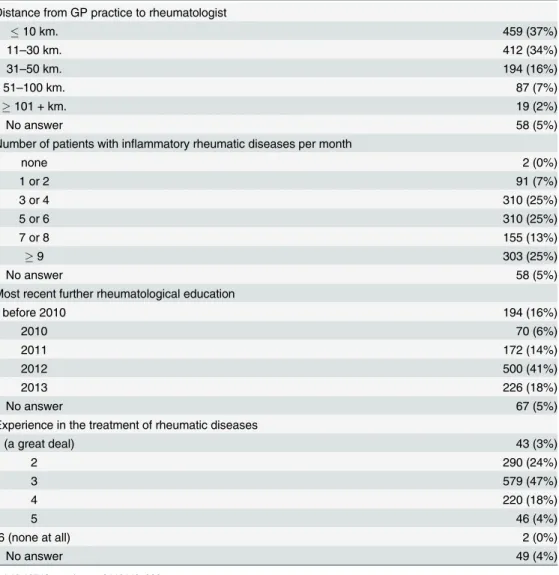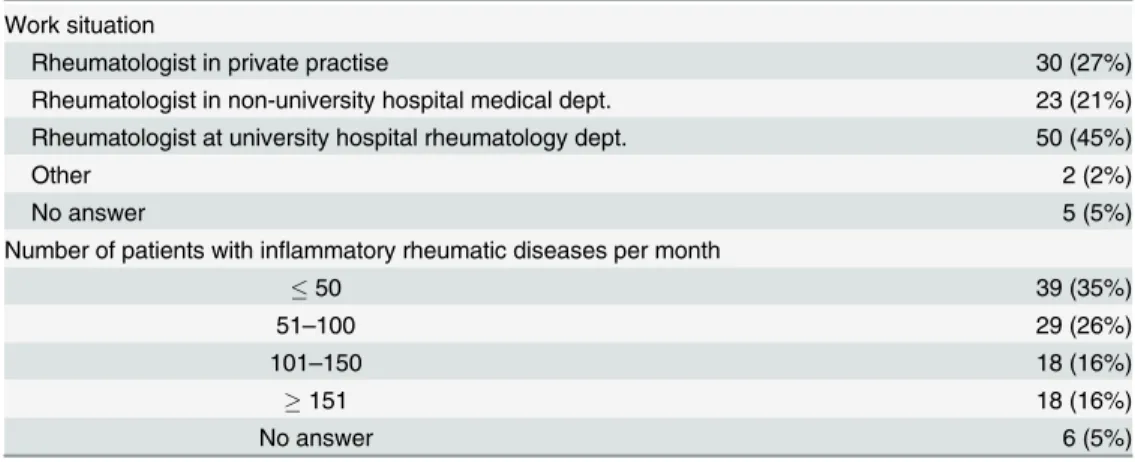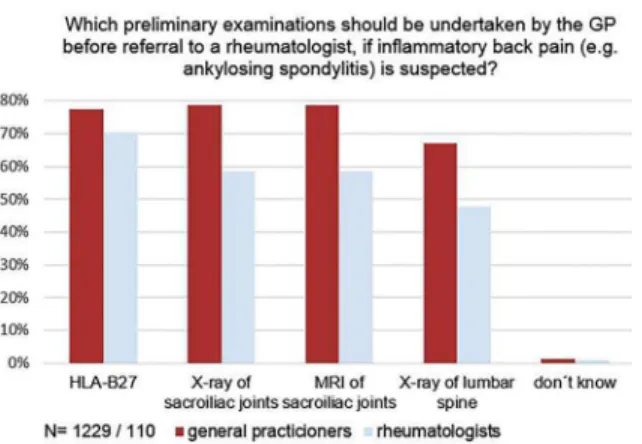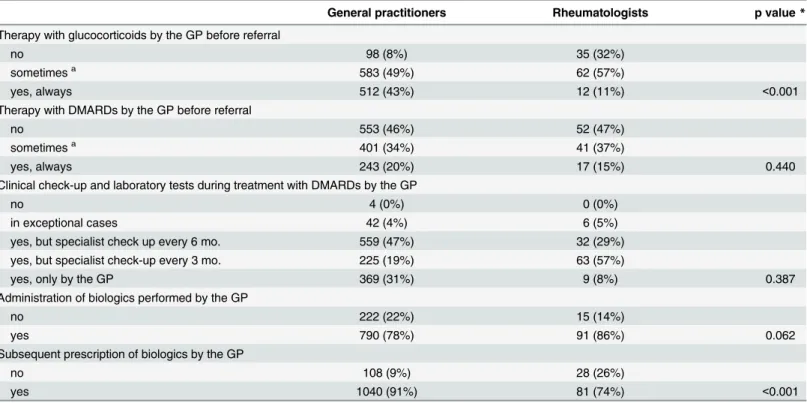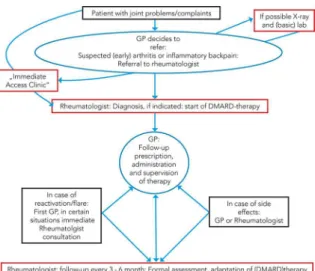Interface Management between General
Practitioners and Rheumatologists
—
Results
of a Survey Defining a Concept for Future
Joint Recommendations
Rudolf Puchner1*, Michael Edlinger2, Erich Mur3, Gabriele Eberl4, Manfred Herold3, Peter Kufner5, Antonia Puchner6, Stephan E. Puchner7, Kurt Redlich6, Alois Alkin8, Klaus Machold6
1Rheumatology Practise Dr Puchner, Wels, Austria,2Department of Medical Statistics, Informatics and Health Economics, Medical University of Innsbruck, Innsbruck, Austria,3Department of Internal Medicine I, Medical University of Innsbruck, Innsbruck Austria,4Klinikum Malcherhof Baden, Baden bei Wien, Austria, 5Private Practise Dr Kufner, Innsbruck, Austria,6Division of Rheumatology, Department of Internal Medicine III, Medical University of Vienna, Vienna, Austria,7Department of Orthopaedic Surgery, Medical University of Vienna, Vienna, Austria,8Centre of Excellence in Medicine, Linz, Austria
*rudolf.puchner@cc-net.at
Abstract
Objective
To measure the views of general practitioners (GPs) and rheumatologists in a nationwide evaluation, so as to optimise their cooperation in managing patients with inflammatory rheu-matic diseases.
Methods
A questionnaire covering aspects of collaboration was sent, both by mail and/or by email, to all GPs and rheumatologists in Austria. Topics covered were (i) examinations and interven-tions to be performed before referral, (ii) the spectrum of diseases to be referred, and (iii) the role of GPs in follow-up and continuous management of patients.
Results
1,229 GPs of the 4,016 GPs (31%) and 110 of the 180 rheumatologists (61%) responded to the questionnaire. In cases of suspected arthritis, 99% of the GPs and 92% of the rheuma-tologists recommended specific laboratory tests, and 92% and 70%, respectively, recom-mended X-rays of affected joints before referral. Rheumatoid arthritis and spondyloarthritis, psoriatic arthritis and connective tissue disease were unanimously seen as indications for referral to a rheumatologist. Only 12% of rheumatologists felt responsible for the treatment of hand osteoarthritis and fibromyalgia. 80% of GPs and 85% of rheumatologists were of the opinion that treatment with disease-modifying drugs should be initiated by a specialist. Subsequent drug prescription and administration by GPs was supported by a majority of
OPEN ACCESS
Citation:Puchner R, Edlinger M, Mur E, Eberl G, Herold M, Kufner P, et al. (2016) Interface Management between General Practitioners and Rheumatologists—Results of a Survey Defining a Concept for Future Joint Recommendations. PLoS ONE 11(1): e0146149. doi:10.1371/journal. pone.0146149
Editor:James T. Rosenbaum, Oregon Health & Science University, UNITED STATES
Received:May 24, 2015
Accepted:December 14, 2015
Published:January 7, 2016
Copyright:© 2016 Puchner et al. This is an open access article distributed under the terms of the
Creative Commons Attribution License, which permits unrestricted use, distribution, and reproduction in any medium, provided the original author and source are credited.
Data Availability Statement:All relevant data are within the paper and its Supporting Information files.
GPs and rheumatologists, with a concomitant rheumatologist follow-up every three to six months.
Conclusion
The considerable consensus between the two professional groups constitutes a solid base for future joint recommendations, with the aim to accelerate the diagnostic process and the initiation of adequate therapy.
Introduction
Acute and chronic rheumatic diseases, such as osteoarthritis, gout or degenerative spine dis-ease, are frequent and have a profound impact on patients’and their families’quality of life [1,
2]. Patients usually suffer from pain and disability to a varying extent. Therefore, a considerable amount of general practitioners' (GPs) working time is devoted to the management of rheu-matic diseases [3]. Among conditions with a component of arthritis, such as rheumatoid arthritis (RA), connective tissue diseases (CTDs) or ankylosing spondylitis (AS), which are less common than the degenerative ones, many, such as RA, require rapid referral to a specialist. The reason being that they can inflict damage within a short period of time. In general, a GP is the primary contact for all these patients and they then have to decide whether rheumatological consultation is required, or how rapidly patients should be referred. A delay in the referral to a specialist of a patient with early rheumatoid arthritis increases the danger of joint destruction, with the potential risk of longer sick leave, early disability, or the initiation of pathways to costly surgical intervention later. Indeed, for more than a decade, the development of new drugs has decisively changed and improved the treatment options and outcome of chronic inflammatory rheumatic diseases [4–9]. Whereas, in the 1990s rheumatologists were content with somewhat reducing the swollen joint count using disease modifying, anti-rheumatic drugs (DMARDs), nowadays a“treat-to-target”approach is preferred with the aim of achieving remission, or at least low disease activity [10] and today the respective therapeutic means are available.
On the other hand, the unnecessary referral of patients with a rheumatic condition to a rheumatologist is the most important reason for the increasing work overload in rheumatology practices, distracting them from patients with more complex rheumatic problems such as acute and chronic inflammatory diseases [3]. Therefore, communication and information exchange between rheumatologists and GPs needs to be improved, and to this end, referral recommenda-tions were already developed many years ago, at least for RA and AS [11,12]. This was done in the hope of reducing waiting times in rheumatology outpatient clinics and practices by a better selection of patients, earlier diagnosis and earlier implementation of therapy, thereby resulting in better patient outcome.
The primary-specialist care interface is a key organisational feature of many health care sys-tems. Some countries have a similar formal referral system, for example, the UK, the Nether-lands and Denmark, where primary care physicians provide health care and act as gatekeepers with responsibility for defining which patients require specialist care. Other countries have a less formalised referral system, for example, Germany, Switzerland and Austria, where patients have free choice of doctor, whether primary care physician or specialist [13].
Overall, delays in consulting a GP, delays in referral to a rheumatologist, waiting times for appointments and delays in correct diagnosis by a rheumatologist after referral, are the main obstacles to rapid initiation of appropriate therapy.
However, even with the application of appropriate referral recommendations, the delay in the diagnostic process with the rheumatologist still might not be reduced. This delay could be decreased if the patient is referred together with appropriate test results, whether labora-tory or imaging. Therefore, it may be important to decide which tests or procedures would help to improve diagnostic accuracy and avoid inappropriate testing or referrals. This latter aspect was addressed in this study among GPs and rheumatologists, whose opinions regard-ing appropriate testregard-ing before referral were assessed usregard-ing a questionnaire survey. Topics included requests for laboratory tests, investigations and follow-up examinations performed by GPs, as well as listing the patients with a defined spectrum of diseases who should be referred to the specialist.
Our aim was to compare results of both groups of physicians in order to find possibilities for improving the efficiency of this cooperation between GPs and rheumatologists.
Materials and Methods
In cooperation with the board of the Austrian Society of Rheumatology, a questionnaire was designed to address various aspects of cooperation between rheumatologists and GPs. A pilot phase was carried out in which 46 out of 98 invited rheumatologists participated. The pilot and final questionnaires differed only slightly in wording. In a second phase, 100 GPs in training practices were interviewed. Additionally the understanding of the meaning of“a clinical suspi-cion of Lyme disease”, of“antibodies against citrullinated peptides (ACPA)”and“ inflamma-tory back pain”was tested in a smaller sample of GPs, with results indicating sufficient knowledge.
The final questionnaire was the result of expert evaluation by board member rheumatolo-gists, a GP, an epidemiologist, and a sociologist. The form was almost identical for both GPs and rheumatologists, except for three questions about professional experience in the treatment of rheumatic diseases which was only for GPs.
Questions addressed the following issues:
- The laboratory tests and radiological examinations that should be ordered by GPs before referral to a rheumatologist, in patients with arthritis or suspicion of inflammatory back pain.
- The rheumatic diseases that should be presented to a rheumatologist and how their refer-ral should be organised.
- The interventions that should be performed by GPs in patients with inflammatory rheu-matic diseases before referral to a rheumatologist and afterwards during the long-term treatment of the disease.
The questionnaire, with its covering letter, was sent out to all 4,016 Austrian GPs and to all 180 Austrian internists with a rheumatology subspecialty. We deliberately excluded retired rheumatologists and those with formal qualification but no current work as a rheumatologist. The participants were given a five week deadline to return the questionnaire; a reminder was sent after three weeks. The survey period was from the 12thof June to the 15thof July 2013. The questionnaire could be filled out either online or returned by regular mail.
The survey was a project of the Austrian Society of Rheumatology and was supported by the Austrian Medical Association and the Austrian Society for General Practice and Family Medicine.
Fisher's exact test orχ2-test for trend was used to statistically evaluate differences between
In our study an ethics committee was not necessary. There was no research in humans. No patient data was obtained in this questionnaire. No patients were involved in this study.
This questionnaire survey exclusively asked for health care data. No questions referred to any personal data regarding patient’s personal medical history were asked. General practition-ers and rheumatologists were asked for their professional opinions related to health care management.
All practising General practitioners and rheumatologists in Austria, all of them are regis-tered in the Austrian Medical Association were invited to participate in this survey.
The authors of the manuscript had no access to identifying participant information at any time.
Results
1,229 of the 4,016 GPs (31%) and 110 of the 180 rheumatologists (61%) sent back evaluable ques-tionnaires (S1 Dataset). Demographic data and other characteristics such as an urban or rural area of workplace are given in Tables1,2and3. Most GPs see 3 to 6 patients with inflammatory rheumatic diseases in one month. Asked about their competence in its treatment, the majority of GPs rated themselves at a minimum of 3 on a scale of 1 to 6; 1 denoting very competent and 6 not at all. For over 70% of GPs the distance from their practice to the nearest rheumatologist was less than 30 km (Table 2).The majority of rheumatologists are hospital based (Table 3).
Pre-referral tests recommended for cases of arthritis or suspected,
inflammatory back pain
In cases of monoarthritis, oligoarthritis, or polyarthritis 1,215 (100%) of the GPs and 101 (92%) of the rheumatologists recommended laboratory testing before referral to a rheumatolo-gist. There were similar results among all participants calling for tests for acute phase parame-ters and complete blood count, before referral. Fewer rheumatologists than GPs recommended rheumatoid factor testing (77% vs 91%, p<0.001), a small majority of GPs (59%) and
rheuma-tologists (62%) voted for testing for antibodies against citrullinated peptides (Fig 1). Few GPs recommended routine Borrelia serology, although they did so significantly more frequently than rheumatologists (17% vs. 2% p<0.001). In cases of a substantiated clinical suspicion of
Lyme disease however, 77% of GPs and 57% of rheumatologists said they would prefer Borrelia serology determined in advance.
Table 1. Characteristics of the physicians who responded to the survey.
General practitioners n (%) Rheumatologists n (%)
Participation 1229 (31%) 110 (61%)
Age (years), median (IQR) 55 (49; 59) 50 (43; 54)
No answer 42 (3%) 1 (1%)
Sex
Male 878 (71%) 84 (76%)
No answer 3 (0%) 1 (1%)
Population of municipality where workplace is situated
- 10,000 734 (60%) 17 (15%)
10,001–100,000 217 (18%) 34 (31%)
100,001 + 196 (16%) 49 (45%)
No answer 82 (7%) 10 (9%)
Abbreviation: IQR = interquartile range.
Conventional radiological imaging of the affected joints in cases of arthritis before referral was recommended by 94% of the GPs and 71% of the rheumatologists (p<0.001).
In patients with suspected inflammatory back pain, again, a majority of both GPs and rheu-matologists wanted HLA-B27 tested, prior to referral to the specialist. 81% of the GPs and 63% of the rheumatologists also requested a conventional x-ray of the sacroiliac joints and 69% and 51% respectively, a conventional X-ray of the lumbar spine. 58% of the GPs and 44% of the rheumatologists asked for both, and 30% and 18%, respectively, required just one of these (out of these, 70% of the GPs and 80% of the rheumatologists wanted an x-ray of the sacroiliac joints). In both groups, 25% recommended magnetic resonance imaging (MRI) prior to referral to the rheumatologist (Fig 2).
Diseases to be referred to a rheumatologist (in addition to monoarthritis,
oligoarthritis and polyarthritis, or suspicion of inflammatory back pain)
The majority of responding GPs (78%) and rheumatologists (90%) stated that patients with connective tissue disease should always be referred to a rheumatologist, even in the absence ofTable 2. GPs’characteristics.
Distance from GP practice to rheumatologist
10 km. 459 (37%)
11–30 km. 412 (34%)
31–50 km. 194 (16%)
51–100 km. 87 (7%)
101 + km. 19 (2%)
No answer 58 (5%)
Number of patients with inflammatory rheumatic diseases per month
none 2 (0%)
1 or 2 91 (7%)
3 or 4 310 (25%)
5 or 6 310 (25%)
7 or 8 155 (13%)
9 303 (25%)
No answer 58 (5%)
Most recent further rheumatological education
before 2010 194 (16%)
2010 70 (6%)
2011 172 (14%)
2012 500 (41%)
2013 226 (18%)
No answer 67 (5%)
Experience in the treatment of rheumatic diseases
1 (a great deal) 43 (3%)
2 290 (24%)
3 579 (47%)
4 220 (18%)
5 46 (4%)
6 (none at all) 2 (0%)
No answer 49 (4%)
joint involvement. In addition, the respondents felt that patients with psoriatic arthritis should be presented to a specialist in case of joint involvement (81% and 82% respectively), and 18% of rheumatologists also wanted to concern themselves with those psoriasis patients not display-ing joint involvement, where 12% of the GPs felt that was necessary.
Only 11% of the GPs and 12% of the rheumatologists thought that patients with osteoarthri-tis of the hands should always see a rheumatologist, while 65% and 77% respectively, recom-mended presentation of these patients for differential diagnosis in case of active/inflammatory arthritis. With regard to suspected fibromyalgia, 89% of GPs would refer these patients: 35% always and 54% of them only to rule out inflammatory rheumatic disease. Among the rheuma-tologists 12% always felt responsible for the treatment of such patients, while 74% were of the opinion that patients with fibromyalgia should only present to a rheumatologist to rule out inflammatory rheumatic disease. In the case of polymyalgia rheumatica, 53% of the GPs and 84% of the rheumatologists suggested consistent referral of suspected cases to the specialist, another 45% of the GPs would refer only if atypical.
Table 3. Rheumatologists’characteristics.
Work situation
Rheumatologist in private practise 30 (27%)
Rheumatologist in non-university hospital medical dept. 23 (21%) Rheumatologist at university hospital rheumatology dept. 50 (45%)
Other 2 (2%)
No answer 5 (5%)
Number of patients with inflammatory rheumatic diseases per month
50 39 (35%)
51–100 29 (26%)
101–150 18 (16%)
151 18 (16%)
No answer 6 (5%)
doi:10.1371/journal.pone.0146149.t003
Fig 1. Opinion on laboratory examinations to be performed by the GP prior to referral to the rheumatologist in case of arthritis.Abbreviations: ESR, erythrocyte sedimentation rate; CRP, C-reactive protein; CBC, complete blood count; ALT, alanine transaminase; GGT, gamma-glutamyl transferase; UA, uric acid; Crea, creatinine; RF, rheumatoid factor; ACPA, antibodies against citrullinated protein/peptide antigens; ANA, anti-nuclear-antibodies. The differences between GPs and rheumatologists were statistically significant for ALT (p<0.001), Uric acid (p = 0.001), Creatinine (p = 0.035), RF (p<0.001), ANA (p<0.001).*p
value based on Fisher's exact test.
Interventions by GPs in patients with inflammatory rheumatic diseases
before referral to a rheumatologist
GPs and rheumatologists were asked if GPs should start glucocorticoid (GC) treatment in patients that had shown an insufficient response to non-steroidal anti-inflammatory drugs (NSAIDs). There was significant disagreement between both groups (Table 4). Whereas 43% of GPs would always prescribe GC, among the rheumatologists only 11% were of the opinion that they should be prescribed by the GP before referral at all (p<0.001) and 32% even
discour-aged their prescription to avoid masking of disease symptoms. There were significant differ-ences in varying demographics of GPs. In urban areas (>10000 inhabitants) GPs tend towards
saying“no”(chi-squared test for trend, p = 0, 01). GPs with more self-declared experience in the field of musculoskeletal disorders (group 1 and 2 seeTable 3) have a strong tendency to say
“yes”(chi-squared test for trend, p<0,001).
GPs and rheumatologists generally agreed that initiation of therapy with synthetic disease modifying drugs (sDMARDs) should only be done by a specialist for rheumatic diseases and a third of both groups also agreed that in special circumstances, such as the limited availability of a rheumatologist, sDMARD therapy could also be started by a GP.
For patients with stable disease and/or on stable treatment, the majority of the rheumatolo-gists questioned believed that clinical check-ups and lab results should be the responsibility of the GP, but that specialist appointments should take place every three to six months. Also, a majority of the GPs were of the same opinion, although roughly one third of them believed that clinical check-ups and lab results should be the sole responsibility of the GP.
GPs and rheumatologists agreed that the administration of biologic DMARDs (bDMARDs) could also be performed by GPs. Regarding follow-up prescriptions of bDMARDs, significantly fewer rheumatologists than GPs thought that this could be left to the GP (p<0.001) (Table 4).
The respondents´ opinions were markedly split regarding their preferred courses of action in cases of worsening inflammatory joint disease and/or treatment side-effects. Only 12% of the GPs, but 51% of the rheumatologists, would opt for immediate presentation to a specialist in these cases, the rest would leave the initial examination to the GP (88% and 49% respectively p<0.001). In cases of side-effects of treatment, 78% of the GPs and 48% of the rheumatologists
believed that the GP should be visited first; 22% and 52% respectively, believed that the specialist should be involved immediately (p<0.001). In urban areas the majority of the GPs voted for
Fig 2. Opinion on necessity of examinations to be acquired by the GP before referral to a rheumatologist, if inflammatory back pain is suspected.The difference between GPs and rheumatologists was statistically significant for x-ray of sacroiliac joints and x-ray of lumbar spine (both p<0.001).*p value based on Fisher's exact test
immediate contact with the specialist (Fisher's exact test, p<0,001). GPs with more self-declared
experience prefer to see those patients first in their practice (Fisher's exact test p = 0, 03).
Urgent referrals
GPs and rheumatologists were asked about correct procedure in cases of urgent referral. 69% of GPs and 87% of rheumatologists preferred telephone contact by the GP. To simplify the rec-ognition of urgent patients the word“urgent”on the referral letter was appreciated by 40% of GPs and 20% of rheumatologists; a service telephone at rheumatology outpatient departments by 37% and 22%; and email contact with guaranteed response within a certain time limit, by 14% and 18% respectively (multiple answers were possible).
Discussion
In the present study we surveyed practising GPs and rheumatologists in Austria for their opin-ions and recommendatopin-ions regarding their respective roles in the management of patients with rheumatic problems. The results demonstrate that a vast majority, of both GPs and rheumatol-ogists, prefer to have some laboratory results and radiological examinations of affected joints available before first consultation of a specialist, in order to allow acceleration of the diagnostic process and initiation of treatment. With regard to the spectrum of diseases, the majority of respondents stated that in addition to monoarthritis, oligoarthritis and polyarthritis (or suspi-cion of inflammatory back pain), patients with connective tissue diseases should definitely be seen by a rheumatologist.
Table 4. Opinion of general practitioners (n = 1229) and rheumatologists (n = 110) on interventions by general practitioners in patients with inflam-matory rheumatic diseases.
General practitioners Rheumatologists p value*
Therapy with glucocorticoids by the GP before referral
no 98 (8%) 35 (32%)
sometimesa 583 (49%) 62 (57%)
yes, always 512 (43%) 12 (11%) <0.001
Therapy with DMARDs by the GP before referral
no 553 (46%) 52 (47%)
sometimesa 401 (34%) 41 (37%)
yes, always 243 (20%) 17 (15%) 0.440
Clinical check-up and laboratory tests during treatment with DMARDs by the GP
no 4 (0%) 0 (0%)
in exceptional cases 42 (4%) 6 (5%)
yes, but specialist check up every 6 mo. 559 (47%) 32 (29%)
yes, but specialist check-up every 3 mo. 225 (19%) 63 (57%)
yes, only by the GP 369 (31%) 9 (8%) 0.387
Administration of biologics performed by the GP
no 222 (22%) 15 (14%)
yes 790 (78%) 91 (86%) 0.062
Subsequent prescription of biologics by the GP
no 108 (9%) 28 (26%)
yes 1040 (91%) 81 (74%) <0.001
aRestricted to special circumstances (e.g. extraordinarily long waiting times for the rheumatology appointment or limited availability of a rheumatologist) *p value based onχ2for trend or Fisher's exact test
Only a minority of the surveyed rheumatologists regarded themselves as the primary refer-ral address for patients who have osteoarthritis and fibromyalgia with the exception of cases in which an inflammatory rheumatic disease has to be excluded. Regarding fibromyalgia, this opinion is supported by a Dutch study showing that fibromyalgia can also be diagnosed and adequately treated by a skilled GP [7]. The implication of these answers might be a shared care through GPs and rheumatologists. The GP is the first and most important contact person and a gatekeeper, while the rheumatologist rules out an inflammatory rheumatic disease and gives support in pain management. However, the roles of psychiatrists, pain specialists, physical medicine specialists and non-physician clinicians who might also be involved in fibromyalgia care was not a distinct topic of the survey.
The discordant view about GC usage needs further discussion. The start of GC treatment by a GP before referral, especially in early arthritis patients, could mask symptoms and therefore delay diagnosis. It should be reserved for emergency situations such as the severe manifestation of symptoms or unduly long waiting times for a specialist appointment. Future training and the introduction of guidelines for appropriate use of GC by GPs might be of help. Likewise, fol-low-up prescription of bDMARDs by GPs which is supported by a majority of rheumatologists but is seen feasible by significantly more GPs, may benefit from clear guidelines. Clinical and laboratory monitoring of DMARDs as well as the administration of bDMARDs (with the exception of rituximab) by GPs is seen as feasible. Because the latter appears safe [14,15] this may help economise on the care of patients with rheumatic diseases further. Supervision of treatment with DMARDs may also be executed by GPs, with three to six-monthly specialist appointments in order to optimise patient`s security.
Referral recommendations, at least for RA and AS, are well established and were published some years ago [11,12] as a tool for primary care doctors to identify potential patients with active disease. The aim of our study was to facilitate interface management between primary and secondary care.
According to the literature, GP’s in Austria and Germany see an average of 0.4 incident RA patients per year—not only is RA hard to diagnose, it is also relatively rare in a GP’s office com-pared to, e.g., cardiovascular diseases. [16,17].
In a severe disease like RA it seems to be more important to upgrade interface management than to put too much effort in GPs’training.
The major limitation of this study is its restriction to the Austrian health care system. In this system, in a country with universal health insurance coverage, the GPs role is quite extensive and the burden of caring for a multitude of medical complaints restricts their ability to deal with more complex cases. Whereas this is probably also true in many other countries, the sys-tem currently assigns no role to other professions such as specialist nurses or therapists to relieve or to assist the GP in management of e.g. referrals, follow-up or repeat prescriptions. This may have influenced some of the responses in this study.
for rheumatic diseases/patients. It appears possible that the respondents were more interested in rheumatological problems and therefore more motivated to answer the survey.
Taken together, the results of our survey demonstrate the necessity for clearly defined arrangements for optimised co-operation between GPs and rheumatologists (Fig 3). In many areas a high degree of agreement between the surveyed GPs and rheumatologists was found, in particular with regard to the recommended pre-referral tests. The important role of the GP in follow-up and surveillance of the patients is acknowledged by the majority of both professions. The management of patients in cases of disease flare or drug side effects needs further discus-sion. The possibility of rapid access rheumatology consultation could facilitate and accelerate treatment in these situations [20].
A shared responsibility of both specialists and primary care physicians for treating patients with inflammatory rheumatic diseases is repeatedly discussed and called for in the literature [21–24]. We carried out a nationwide evaluation on the views of primary care providers and rheumatologists, as far as we know the first one ever done up to now, in order to improve chronic disease care. There is considerable agreement between the two professional groups and such consensus constitutes a solid base onto which joint recommendations can be formulated. Such joint recommendations, developed by all professionals concerned, will potentially find more acceptance and could lead to optimisation of care.
This would probably be useful for (i) reducing the time to diagnosis and initiation of therapy for patients with RA and other inflammatory rheumatic diseases, (ii) improving cooperative care between GPs and rheumatologists after diagnoses and treatments have been established, and (iii) last but not least, lowering overall costs.
Supporting Information
S1 Dataset.
(XLSX)
Acknowledgments
We want to thank the Austrian Medical Association and the Austrian Society for General Prac-tice and Family Medicine for their promotion and support.
Fig 3. Optimised management of RA.
Author Contributions
Conceived and designed the experiments: RP EM KM. Performed the experiments: ME GE MH PK AP SEP KR AA. Analyzed the data: RP ME AA KM. Wrote the paper: RP ME KM.
References
1. Bernatsky S, Feldman D, De Civita M, Haggerty J, Tousignant P, Legaré J, et al. Optimal care for rheu-matoid arthritis: a focus group study. Clin Rheumatol 2010; 29:645–57 doi: 10.1007/s10067-010-1383-9PMID:20127397
2. Roux C, Guillemin F, Boini S, Longuetaud F, Arnold N, Hercberg S, et al. Impact of musculoskeletal dis-orders on quality of life: an inception cohort study. Ann Rheum Dis 2005; 64:606–11 PMID:15576417 3. Roberts C, Adjebajo AO, Long S. Improving the quality of care of musculoskeletal conditions in primary
care. Rheumatology (Oxford) 2002; 41:503–8
4. Qian J, Ehrmann Feldman D, Bissonauth A, Ménard HA, Panapolis P, Stein M, et al. A retrospective review of rheumatology referral wait times within a health centre in Quebec, Canada. Rheumatol Int 2010; 30:705–7 doi:10.1007/s00296-009-1297-5PMID:20020136
5. Bykerk V, Emery P. Delay in receiving rheumatology care leads to long term harm. Arthritis Rheum 2010; 62:3519–21 doi:10.1002/art.27691PMID:20722032
6. Van der Linden MP, le Cessie S, Raza K, von der Woude D, Knevel R, Huizinga TW, et al. Long term impact of delay in assessment of patients with early arthritis. Arthritis Rheum 2010; 62:3537–46 doi:10. 1002/art.27692PMID:20722031
7. Schulpen GJ, Vierhout WP, van der Heijde DM, Landewé RB, Winkens RA, van der Linden S. Joint consultation of general practitioner and rheumatologist: does it matter? Ann Rheum Dis 2003; 62:159–
62 PMID:12525386
8. Fautrel B, Benhamou M, Foltz V, Rincheval N, Rat AC, Combe B, et al. Early referral to the rheumatolo-gist for early arthritis patients: evidence for suboptimal care. Results from the ESPOIR cohort. Rheuma-tology (Oxford) 2010; 49:147–55
9. Robinson PC, Taylor WJ. Time to treatment in rheumatoid arthritis: factors associated with time to treat-ment initiation and urgent triage assesstreat-ment of general practitioner referrals. J Clin Rheumatol 2010; 16:267–73 doi:10.1097/RHU.0b013e3181eeb499PMID:20689443
10. Smolen JS: Treat-to-target: rationale and strategies. Clin Exp Rheumatol 2012; 30:S2–S6 PMID: 23073266
11. Emery P, Breedfeld FC, Dougados M, Kalden JR, Schiff MH, Smolen JS. Early referral recommenda-tion for newly diagnosed rheumatoid arthritis: evidence based development of a clinical guide. Ann Rheum Dis 2002; 61:290–97 PMID:11874828
12. Sieper J, Ruwaleit M. Early referral recommendations for ankylosing spondylitis (including pre-radio-graphic and radiopre-radio-graphic forms) in primary care. Ann Rheum Dis 2005; 64:659–63 PMID:15528281 13. Grimshaw JM, Winkens RA, Shirran L, Cunningham C, Mayhew A, Thomas R, Fraser C. Interventions
to improve outpatient referrals from primary care to secondary care. Cochrane Database Syst Rev. 2005 Jul 20;(3):CD005471.
14. Pham T, Bachelez H, Berthelot JM, Blacher J, Bouhnik Y, Claudepierre P, et al. TNF alpha antagonist therapy and safety monitoring. Joint Bone Spine 2011; 78:15–185 doi:10.1016/S1297-319X(11) 70001-XPMID:21703545
15. Stuby U, Biesenbach G, Pieringer H. Administration of infliximab in general practitioners’offices is safe. Clin Rheumatol 2007; 26:1863–66 PMID:17322962
16. Puchner R, Hochreiter R, Vavrovsky A. Improving patient flow of people with rheumatoid arthritis has the potential to simultaneously improve health outcomes and reduce direct costs. Wien klin Wochenschr 2014; 126:S227. doi:10.1007/s00508-014-0671-9
17. Westhoff G et al. [Diagnostic spectrum, treatment indication and symptom duration in initial referrals to the rheumatologist]. Z Rheumatol 2010; 69(10):910–8. doi:10.1007/s00393-010-0715-0PMID: 21088969
18. Behmann M, Schmiemann G, Lingner H, Kühne F, Hummers-Pradier E, Schneider N. Job satisfaction among primary care physicians: results of a survey. Dtsch Arztebl Int 2012; 109(11):193–200 doi:10. 3238/arztebl.2012.0193PMID:22509226
20. Gärtner M, Fabrizii JP, Koban E, Holbik M, Machold LP, Smolen JS, et al. Immediate access rheumatol-ogy clinic: efficiency and outcomes. Ann Rheum Dis 2012; 71:363–68 doi: 10.1136/annrheumdis-2011-200315PMID:21989539
21. Raza K, Stack R, Kumar K, Filer A, Detert J, Bastian H, et al. Delays in assessment of patients with rheumatoid arthritis: variations across Europe. Ann Rheum Dis 2011; 70:1822–25 doi:10.1136/ard. 2011.151902PMID:21821867
22. Villeneuve E, Nam JL, Bell MJ, Deighton CM, Felson DT, Hazes JM, et al. A systemic literature review of strategies promoting early referral and reducing delays in the diagnosis and management of inflam-matory arthritis. Ann Rheum Dis 2013; 72:13–22 doi:10.1136/annrheumdis-2011-201063PMID: 22532640
23. Harrington T. Improving access to rheumatology care: a continuing challenge. J Rheumatol 2008; 35:1233–34 PMID:18609729

